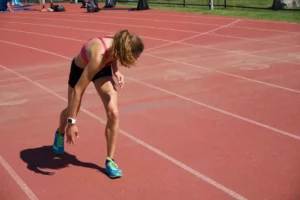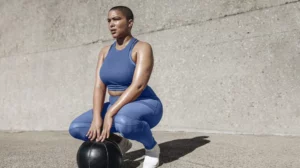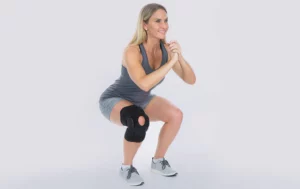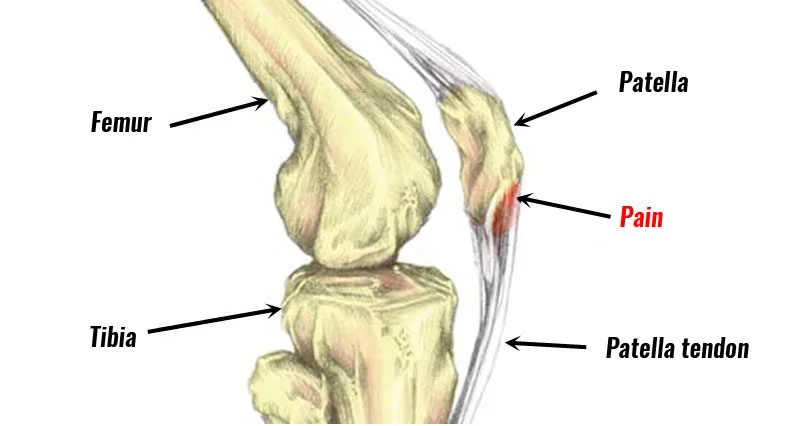Often referred to as “jumper’s knee,” patellar tendonitis is a common ailment among athletes and fitness enthusiasts. It’s characterized by pain and inflammation in the patellar tendon, which links the kneecap (patella) to the shinbone (tibia). In this blog post, we’ll delve deep into the world of patellar tendonitis, exploring its causes, symptoms, and effective strategies for management.
Contents
What Is Patellar Tendonitis?
 Patellar Tendonitis, commonly known as “jumper’s knee,” is an inflammation of the patellar tendon. This is a vital structure that connects the kneecap (patella) to the shinbone (tibia). This tendon plays a crucial role in the extension of the knee. And enabling activities like walking, running, and jumping.
Patellar Tendonitis, commonly known as “jumper’s knee,” is an inflammation of the patellar tendon. This is a vital structure that connects the kneecap (patella) to the shinbone (tibia). This tendon plays a crucial role in the extension of the knee. And enabling activities like walking, running, and jumping.
The condition predominantly arises from overuse and repetitive strain on the knee. Particularly from activities that involve frequent jumping, like basketball or volleyball. Early diagnosis and appropriate treatment can aid in swift recovery and prevent progression to more chronic issues.
What Does A Patellar Tendonitis Feel Like?
Here’s what individuals with this condition often report feeling:
- Localized Pain
The primary symptom is a sharp or aching pain at the front of the knee, specifically where the patellar tendon attaches to the kneecap and the shinbone. The pain might initially be mild and only present during or after specific activities but can intensify with continued strain.
- Tenderness
Pressing on the patellar tendon usually elicits pain or tenderness. This tenderness is typically most pronounced just below the kneecap.
- Activity-induced Pain
Activities that involve knee bending such as squatting, jumping, running, or even walking up and down stairs can exacerbate the pain. In athletes, the pain might be most noticeable when initiating sports or exercise, potentially easing during activity, but then returning afterward.
- Stiffness
The knee may feel stiff, especially after prolonged sitting or inactivity. Morning stiffness is also common.
- Weakness
Some individuals report a sensation of weakness or instability in the affected knee, making it feel as though it might give out during weight-bearing activities.
- Swelling
In some cases, there might be visible swelling around the patellar tendon.
It’s essential to note that while these are common sensations associated with patellar tendonitis, individual experiences can vary. If someone suspects they have this condition, seeking a professional medical evaluation is crucial for an accurate diagnosis and appropriate treatment.
Can I Run With Patellar Tendonitis?
 Running with patellar tendonitis is a matter of severity and individual tolerance. For some, running might exacerbate the pain and inflammation associated with the condition. While others might find they can run with minimal discomfort. However, it’s important to approach the situation with caution.
Running with patellar tendonitis is a matter of severity and individual tolerance. For some, running might exacerbate the pain and inflammation associated with the condition. While others might find they can run with minimal discomfort. However, it’s important to approach the situation with caution.
If you’re experiencing mild symptoms and wish to continue running, it’s crucial to listen to your body. Reduce your mileage, alter your intensity, and avoid hilly terrains that might strain the tendon further. If pain persists or intensifies during or after a run, it’s advisable to rest and seek guidance from a healthcare professional. Continued stress on an inflamed patellar tendon can lead to more severe injuries and prolonged recovery.
What Are The Causes And Risk Factors?
Several factors can predispose an individual to develop this condition or can directly cause it. Here’s a breakdown of the causes and risk factors:
Causes
- Repetitive Strain: Continuous jumping, running, or squatting can put repeated stress on the patellar tendon, leading to microtears. Over time, these microtears can lead to inflammation and pain if they don’t get adequate time to heal.
- Sudden Increase in Activity: Suddenly increasing the intensity, duration, or frequency of physical activities without allowing the body to adjust can strain the patellar tendon.
- Direct Trauma: A direct blow or injury to the tendon, such as from a fall, can instigate patellar tendonitis.
Risk Factors
- Sports: Athletes participate in sports that involve frequent jumping and landing. Such as basketball, volleyball, soccer, and track and field events, are at a higher risk.
- Age: While it can affect people of all ages, patellar tendonitis is more common in younger individuals, especially those in their teens to early thirties, as they are more likely to be involved in high-impact sports.
- Muscle Imbalances: Weak thigh muscles can put more strain on the patellar tendon. Conversely, tight quadriceps muscles might also increase tension in the tendon.
- Misalignment: Biomechanical issues, such as flat feet, can change the way weight is distributed and put added stress on the patellar tendon.
- Weight: Being overweight increases the strain on the knee and its structures, including the patellar tendon.
- Previous Injuries: Having a history of tendon injuries can predispose an individual to develop the condition again.
- Chronic Illnesses: Conditions like diabetes and certain types of arthritis might increase the risk of developing tendinitis.
- Equipment and Technique: Using improper sports equipment, like shoes without proper support, or having poor athletic form or technique, can increase the risk.
It’s essential to note that having one or more risk factors doesn’t mean someone will definitely develop patellar tendonitis. But it does increase the likelihood. Recognizing and addressing these factors can help in preventing or managing the condition.
What Is The Fastest Way To Heal Patellar Tendonitis?
 Healing patellar tendonitis involves a combination of immediate care, therapeutic interventions, and modifications in physical activity. While individual recovery times may vary based on the severity of the condition and the body’s response to treatment, the following steps can expedite healing:
Healing patellar tendonitis involves a combination of immediate care, therapeutic interventions, and modifications in physical activity. While individual recovery times may vary based on the severity of the condition and the body’s response to treatment, the following steps can expedite healing:
1. Rest and Activity Modification
Initially, reduce or eliminate activities that aggravate the tendon, like jumping, squatting, or running. This provides the tendon an opportunity to heal without continual strain.
2. Ice
Apply ice to the affected area for 15-20 minutes several times a day. Especially after activity, to reduce inflammation and alleviate pain.
3. Compression and Elevation
Wearing a compression bandage can help reduce swelling. And elevating the leg can further minimize inflammation.
4. Anti-inflammatory Medications
Over-the-counter nonsteroidal anti-inflammatory drugs (NSAIDs) like ibuprofen can help reduce pain and inflammation. However, always consult with a healthcare professional before starting any medication.
A physical therapist can provide exercises to strengthen the muscles around the knee, improving support for the patellar tendon. They may also offer techniques such as ultrasound or massage therapy.
6. Orthotics and Bracing
In some cases, custom orthotics or braces might be recommended to provide additional support and alignment.
It’s crucial to consult with a healthcare professional for an accurate diagnosis and personalized treatment plan. Remember, while these steps can accelerate healing, patience is vital. Pushing through pain or rushing the healing process can exacerbate the condition and prolong recovery.
How Can I Prevent Patellar Tendonitis?
 Prevention is key when it comes to patellar tendonitis. Especially if you’re actively engaged in sports or physical activities that put stress on the knees. Here are some strategies to prevent the onset or recurrence of patellar tendonitis:
Prevention is key when it comes to patellar tendonitis. Especially if you’re actively engaged in sports or physical activities that put stress on the knees. Here are some strategies to prevent the onset or recurrence of patellar tendonitis:
- Warm-Up Properly
Ensure that you have a comprehensive warm-up routine that raises your heart rate. And prepares your muscles and tendons for the activities ahead.
- Cross-Training
Incorporate low-impact activities into your routine, such as swimming or cycling, to give your patellar tendon some respite while maintaining cardiovascular fitness.
- Incorporate Plyometric Exercises
Plyometric exercises, like box jumps or burpees, can help build strength and resilience in the muscles and tendons around the knee when done correctly.
- Maintain Core Strength
A strong core supports your lower body and can help distribute loads more evenly, reducing strain on the knees.
- Stay Hydrated
Proper hydration supports muscle function and tendon elasticity.
- Nutritional Support
Ensure you’re getting essential nutrients that support tendon health, like vitamin C, manganese, and zinc.
- Incorporate Eccentric Exercises
These types of exercises, where the muscle lengthens under tension (like slowly lowering in a squat), can be particularly beneficial for tendon health.
- Regularly Replace Sports Equipment
Make sure to regularly check and replace equipment. Especially shoes, before they wear out and lose their supportive properties.
- Seek Coaching
If you’re into sports or physical activities, having a coach or expert periodically check your form can ensure that you’re not inadvertently placing undue stress on your patellar tendon.
- Stay Informed
As research progresses, new prevention and treatment methods may arise. Stay up-to-date on the latest findings to ensure you’re doing all you can to protect your knee health.
- Regular Rest and Recovery Days
Ensure you schedule days off from intense activities to give your body, especially your tendons, time to recover.
Listening to your body is crucial. If you feel persistent pain or discomfort in the knee area, it’s essential to address it promptly and not push through the pain.
Conclusion
In understanding patellar tendonitis, it’s evident that this common ailment, often dubbed “jumper’s knee,” requires attention and care. While it primarily affects athletes and those involved in high-impact activities, anyone can experience its discomfort. By recognizing its causes and risk factors, implementing preventive measures, and seeking timely treatment, individuals can effectively manage and overcome this condition.
As with many health matters, proactive measures and a commitment to overall knee health remain paramount. This will ensure longevity in our physical pursuits and everyday activities. If you’re experiencing Knee pain, physical therapy for knee pain at PhysioMantra can help: Book an online physical therapy session.



